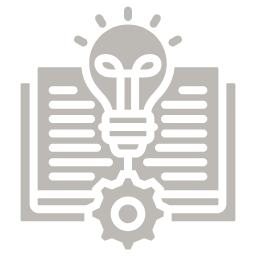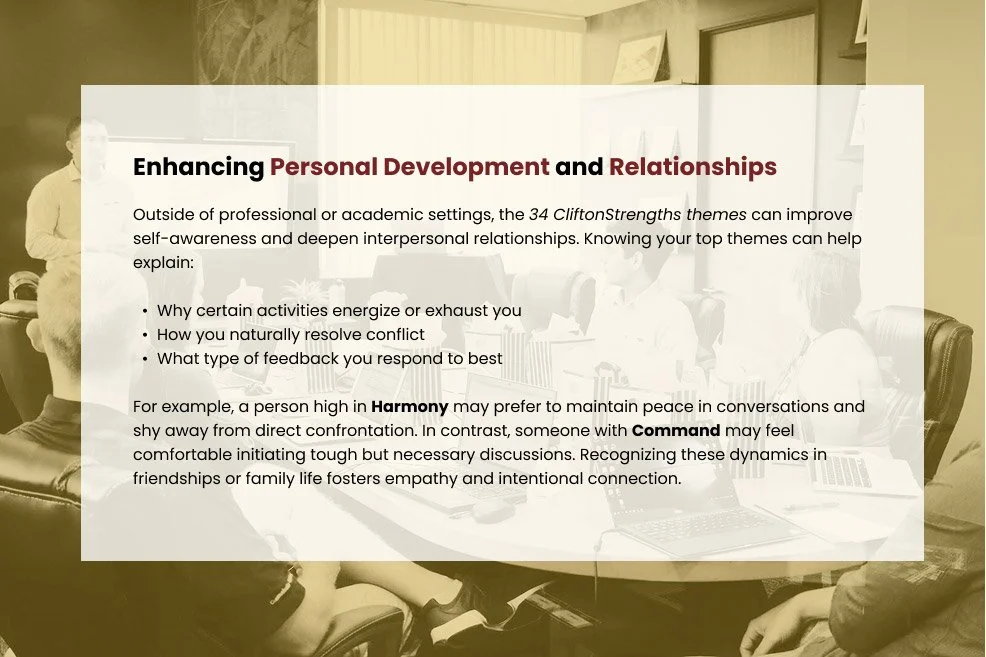THE 34 CLIFTONSTRENGTHS THEME: THE FOUR STRENGTHS DOMAINS
The concept of the 34 CliftonStrengths themes comes from decades of research into human talent and behavior led by Don Clifton, often called the father of strengths-based psychology. Gallup developed the assessment to help people discover and develop what they naturally do best. Rather than focusing on correcting weaknesses, Clifton’s approach encourages individuals and teams to build on their innate strengths to achieve greater performance and satisfaction.
Initially known as the Clifton StrengthsFinder, this tool has evolved into what's now widely referred to as CliftonStrengths 34, representing a full profile of a person’s talent themes.
Each theme highlights a specific way of thinking, feeling, or behaving that can be productively applied. Over time, the tool has been embraced in professional development, education, and organizational culture worldwide.
Executing Domain
Achiever
People strong in the Achiever theme have an internal drive to get things done every day. They often measure their days in terms of productivity and feel a deep sense of satisfaction from crossing items off their to-do list. Even after reaching significant goals, Achievers are driven to start something new, making them reliable contributors in high-output environments.
Arranger
Arrangers are natural coordinators. They thrive in dynamic settings where they can manage multiple variables and bring order to complexity. Their strength lies in being flexible with change and optimizing workflows by reconfiguring resources for better efficiency. They often excel in project management and team leadership roles where logistics are key.
Belief
Those with the Belief theme are guided by a core set of values that shape their actions and decisions. These individuals often prioritize purpose over profit and feel motivated by causes that align with their principles. They bring clarity, conviction, and stability to teams, especially when others may feel uncertain or disconnected.
Consistency
Consistency-minded individuals value fairness and equity. They seek balance in rules and treatment, believing that people should be treated uniformly. Their predictable and impartial approach makes them dependable in roles that require policy enforcement, quality assurance, or impartial decision-making.
Deliberative
Deliberative individuals are careful and vigilant decision-makers. They evaluate risks, consider potential obstacles, and prefer a thoughtful, cautious approach. Their talent is especially useful when navigating uncertainty, as they bring foresight and a protective mindset that reduces potential errors or conflicts.
Discipline
Those with Discipline thrive on structure, order, and routine. They bring clarity to chaos by organizing their environment and processes. While others might get bogged down in the details, people high in Discipline create step-by-step plans to keep teams on track, especially in high-pressure or deadline-driven settings.
Focus
Focus is about setting a direction and sticking to it. These individuals are highly goal-oriented and resist distractions. They keep teams aligned with overarching objectives and often act as anchors when priorities shift. Their ability to maintain direction is crucial during long-term projects or when working toward strategic goals.
Responsibility
People high in Responsibility take ownership of what they commit to. They have strong moral compasses and are dependable, often becoming the ones others trust with important tasks. Their loyalty to their commitments means they follow through—even when it's inconvenient—which earns them credibility and trust
Restorative
Restorative individuals enjoy solving problems. They are energized by challenges and are skilled at identifying what's broken and figuring out how to fix it. Their talent lies in being able to breathe new life into failing processes, systems, or relationships, making them valuable in troubleshooting or turnaround roles.
Influencing Domain
Activator
Activators are known for turning ideas into action. They are often impatient for progress and get restless with too much planning or discussion. Their energy motivates teams to take the first step, and their ability to inspire movement makes them valuable at the start of projects or during strategic pivots.
Command
People with the Command theme bring presence and decisiveness. They naturally take charge and are not afraid to voice opinions, even in uncomfortable situations. Their direct communication style helps cut through ambiguity, often pushing teams toward clarity and resolution during conflict or indecision.
Communication
Those strong in Communication are natural storytellers and explainers. They know how to capture attention and share ideas in ways that are engaging and easy to understand. Whether through writing, speaking, or presenting, they help groups stay connected and aligned with key messages or goals.
Competition
People with this theme are driven by comparison and achievement. They set performance benchmarks based on others and are motivated by winning. Their presence can raise the performance bar for everyone around them, particularly in roles that benefit from high performance metrics and clear rankings.
Maximizer
Maximizers focus on refining strengths rather than fixing weaknesses. They see potential where others may not and are constantly looking for ways to turn strong into exceptional. Whether working with people or processes, they aim for excellence and are particularly skilled in development and improvement roles.
Self-Assurance
Those with Self-Assurance have inner confidence and trust their own judgments. They are independent and often make decisions with minimal validation. Their self-belief can be reassuring to others, especially in uncertain times, and they often act as steadying influences in leadership or advisory roles.
Significance
Significance drives individuals to make an impact and be recognized. They are motivated by visible accomplishments and often strive for excellence because they want their work to matter. This desire fuels their performance and encourages others to raise their standards in shared efforts.
Woo (Winning Others Over)
Woo describes people who enjoy meeting new people and easily build rapport. They are energized by the challenge of turning strangers into acquaintances. Their social fluency helps build networks quickly, which is especially useful in roles involving outreach, recruitment, or public relations.
Relationship Building Domain
Adaptability
People with Adaptability live in the present and adjust easily to change. They are flexible and calm in shifting environments and help others stay grounded when plans go off-course. They shine in roles that require responsiveness, customer service, or fluid scheduling.
Connectedness
Those strong in Connectedness believe everything happens for a reason and that all things are linked. They are often viewed as spiritual or philosophical and bring a sense of purpose and unity to their work. Their perspective helps teams understand the broader context of their actions.
Developer
Developers recognize and nurture the potential in others. They are patient coaches who enjoy helping people grow. They find genuine satisfaction in small steps of improvement and are often found in mentoring, teaching, or leadership development roles.
Empathy
Empathy allows individuals to sense the emotions of others. They intuitively understand what others are feeling, even without words. This makes them powerful allies in emotionally complex environments and trusted confidants in both personal and professional relationships.
Harmony
Those high in Harmony seek agreement and cooperation. They avoid conflict and work to find consensus, smoothing over differences. While they may avoid debate, they are often the glue that keeps teams cohesive and functioning smoothly under pressure.
Includer
Includers actively expand the circle. They notice those who feel left out and make efforts to bring them in. Their instinct to involve others fosters inclusivity and builds strong, unified communities or teams.
Individualization
People with this theme are tuned in to the unique qualities of each person. They tailor interactions and assignments to fit individual strengths and preferences. This makes them effective leaders and managers, especially in diverse or talent-driven settings.
Positivity
Positivity brings energy, enthusiasm, and optimism. These individuals lift the mood of the room and help others see the bright side. Their outlook is contagious and contributes to workplace morale, making them key players in maintaining a healthy culture.
Relator
Relators enjoy forming deep, trusting relationships. They prefer meaningful connections over surface-level interactions and are loyal team members or friends. They’re most energized when working closely with people they know and trust.
Strategic Thinking Domain
Analytical
Analytical thinkers look for patterns and reasons behind outcomes. They need evidence before drawing conclusions and ask hard questions that reveal truth. Their strength lies in logic and objective thinking, making them dependable when data-based decisions are required.
Context
Those with Context value the past. They look back to understand how things came to be, using historical knowledge to inform current choices. Their insights often prevent teams from repeating mistakes and add depth to discussions about strategy or policy.
Futuristic
Futuristic individuals are inspired by visions of what could be. They imagine detailed possibilities and inspire others with their forward-thinking ideas. They are valuable in planning, innovation, and vision-setting roles.
Ideation
People strong in Ideation are fascinated by ideas. They enjoy brainstorming and find connections between seemingly unrelated phenomena. They bring creative energy to teams and are often the source of unconventional solutions.
Input
Input talents are collectors of information. These individuals are curious and love to gather knowledge, tools, or even experiences. They are reliable go-to people for resources and ideas across various topics.
Intellection
Those with Intellection enjoy deep thinking. They often need time alone to process and reflect. Their ability to consider complex issues and their thoughtfulness make them strong strategists or advisors.
Learner
Learners love the process of learning itself. Whether it’s a new skill, subject, or tool, they’re constantly growing. This theme supports roles where adaptation and development are ongoing requirements.
Strategic
Strategic thinkers see patterns and paths where others see complexity. They quickly evaluate possible routes and determine the best one. This talent is especially helpful in navigating uncertain situations or making quick, effective decisions.
Enhancing Your Understanding Of The 34 CliftonStrengths Themes
While the core descriptions of the 34 CliftonStrengths themes provide a strong foundation, true value emerges when we explore how these talents function in practice. The following areas offer fresh perspectives and practical insights to deepen your strengths journey, making the CliftonStrengths 34 themes more applicable and relatable to your daily work and development goals.
Theme Interaction Across Domains
One of the most underexplored yet valuable aspects of strengths development is how different themes interact, especially when they span across domains.
For example, someone with Focus (Executing) might work very differently when paired with Ideation (Strategic Thinking) compared to when it's paired with Harmony (Relationship Building). Recognizing these combinations helps people understand their decision-making style, energy flow, and interpersonal impact more accurately.
By looking at how your top strengths connect, you can better predict team dynamics, conflict patterns, and collaborative potential. A project leader with Command and Empathy may drive results while maintaining team morale, whereas a teammate with Learner and Arranger might bring adaptability and a structured curiosity that enhances agility.
Growth Exercises & Journaling Prompts
Most explanations of the CliftonStrengths 34 themes assume a one-size-fits-all interpretation. However, cultural norms, team expectations, and industry-specific values shape how certain strengths are perceived and used. For instance, Woo might be celebrated in sales-driven environments but seen as intrusive in more reserved or compliance-focused sectors.
Likewise, in multicultural teams, Adaptability may be more crucial for navigating differences in communication styles or decision timelines. Exploring how each strength translates across diverse workplace cultures allows for more respectful and strategic applications, particularly in international or cross-functional teams.
Critique and Limitations of Strengths-Based Models
To move from understanding to mastery, individuals need regular reflection and deliberate practice. Including structured exercises for each of the 34 CliftonStrengths themes can significantly support growth. Journaling prompts like “How did I use Empathy today?” or “When did I rely on Focus to complete a task this week?” encourage awareness and intentionality.
Other practical activities might include:
Weekly strength spotting: Identify when you’ve observed a colleague using their top theme.
Theme balancing: Practice using a less dominant theme in a low-risk setting.
Strength stretching: Apply a theme in an unfamiliar context (e.g., using Input in a social setting).
Such practices not only deepen personal insight but also make strengths development a habit rather than a one-off activity.
Interpreting & Using Assessment Results Effectively
Although widely used, the CliftonStrengths approach isn’t without limitations. One of the most common critiques is that it lacks prescriptive direction—knowing your top five strengths doesn’t automatically tell you how to succeed. Additionally, some argue that it may reinforce fixed mindsets by encouraging people to focus only on what they’re already good at.
Another concern is the lack of transparency in the assessment methodology. While the tool has been validated internally by Gallup, critics point out that third-party studies are limited.
By acknowledging these points, users can better contextualize their results and make informed decisions about how to integrate the framework with other developmental tools.
Role Alignment in Team Dynamics
Once you complete the assessment and receive your CliftonStrengths 34 themes report, the next step is making sense of the results. It’s not just about reading the descriptions—it’s about connecting them to your daily actions and long-term goals.
Here’s how to interpret and apply your results:
Look beyond your Top 5: The full 34 offers insight into potential blind spots or growth edges.
Identify theme clusters: Do your top strengths lean heavily into one domain? That might suggest your natural approach to solving problems or leading teams.
Match strengths with priorities: Use Strategic to plan projects, Responsibility to follow through, or Positivity to boost team morale when it’s needed most.
Strengths in Diverse Cultural & Professional Settings
Each strength can shine or strain depending on the role someone plays within a team. Someone high in Analytical might feel underused in a fast-paced brainstorming session, while a person with Activator may struggle in roles requiring long, detailed planning phases.
Helping team members align their strengths with their responsibilities not only boosts productivity but also enhances engagement. Managers and team leads can use strengths profiles to assign tasks more strategically, foster collaboration by pairing complementary themes, and minimize friction by understanding how different themes might clash.
Regular check-ins, open dialogue about how themes are showing up, and flexible role design can ensure strengths are not just identified—but fully activated within team structures.
Applying CliftonStrengths in Real Life
Understanding the 34 CliftonStrengths themes is only the beginning. True impact comes from applying these insights consistently in everyday situations—at work, in education, and in personal relationships. When used thoughtfully, the CliftonStrengths 34 themes can support more aligned decisions, better collaboration, and ongoing self-growth.
Conclusion On The 34 Cliftonstrengths Themes
Most existing content on the 34 CliftonStrengths themes offers clear definitions and domain groupings. However, after reviewing multiple sources, it's clear that few guide readers on how to use this knowledge beyond understanding their results. While Gallup provides detailed descriptions and some development suggestions, academic PDFs focus more on static reference than dynamic use.
If you're ready to explore your strengths more deeply or implement strengths-based strategies in your team or organization, Strengths School offers tailored support. Through guided workshops, coaching, and team alignment programs, you can unlock the full potential of your CliftonStrengths 34 themes and apply them in the most impactful ways.
Whether you're aiming to build a more cohesive team, enhance your leadership style, or clarify your career direction, Strengths School provides the insight and structure to make that journey actionable and rewarding.
Frequently Asked Questions About The 34 Cliftonstrengths Themes
-
The 34 CliftonStrengths themes are categories of natural talents identified by Gallup that describe how people think, feel, and behave. They are designed to help individuals understand and develop their unique strengths.
-
While results vary by population, Achiever is often reported as one of the most frequently occurring themes worldwide, especially among working professionals.
-
The four domains—Executing, Influencing, Relationship Building, and Strategic Thinking—work together by covering different aspects of performance. Teams with strengths across all domains tend to function more effectively, balancing action, influence, connection, and planning.
-
Core strengths tend to remain stable, but their order or expression may shift slightly over time due to life experiences, roles, or intentional development.
-
Teams can use CliftonStrengths by identifying each member's top themes and aligning roles accordingly. This promotes better communication, task ownership, and collaboration based on complementary talents.
-
Some critiques include its limited external validation, focus on positives without addressing weaknesses, and a lack of actionable guidance for using lower-ranked themes or improving underdeveloped areas.















































